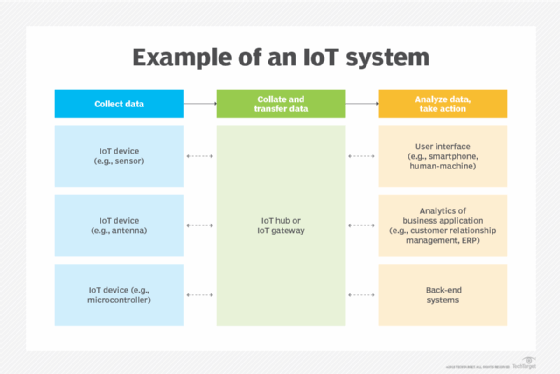What 4 questions can help prepare your network for IoT?
Increasingly, organizations are seeing a marriage of IoT and networking for more efficiency and enhanced services. Here's what you need to know to prepare your networks for IoT.
Intelligence derived from contextual IoT data enables organizations to enhance their operational efficiency and provide improved customer service. The network is an essential component of an IoT architecture, which must provide appropriate bandwidth, latency, security and reliability for edge IoT devices.
Enterprise IT organizations across many -- if not all -- vertical industries are challenged to securely connect a variety of IoT devices to their networks. These devices may include video cameras, sensors, smart meters, inventory trackers, robots, industrial control systems and healthcare devices. Vertical applications include utilities -- metering, manufacturing -- control, agriculture, oil and gas production, healthcare, education, traffic, smart buildings, and logistics.
Each IoT application has unique requirements for bandwidth, latency, and local and central IT intelligence. And each application requires a distinct cost-benefit analysis to justify implementation.
IT organizations are already charged with connecting a wide range of non-PC devices, such as phones and cameras, to the corporate network. As it becomes more pervasive, organizations must prepare their network for IoT to connect large numbers of IoT devices.

Preparing your network for IoT
The key to preparation is asking the right questions to understand network and IT requirements that are unique to IoT applications.
- What are the connectivity options for IoT devices? This depends on their location -- in the field, on the plant floor, in an oil rig or office, for example -- and whether they are mobile or fixed. The second part of this question is to determine how much bandwidth is required -- both upstream and downstream -- and plan a reasonable budget for potential monthly bandwidth costs. IoT connectivity options include Bluetooth, Wi-Fi, 4G LTE, Ethernet, Sigfox, LoRa and LTE-M, among others.
- What is the acceptable amount of latency? Or, how long does a round-trip response take from IoT endpoints to the central control point and back? IoT systems may have one-second latency, which is fine for some applications, but it can be a public safety risk in others. Architecting mobile edge computing nodes can substantially reduce latency for mission-critical applications.
- How can organizations determine the appropriate security risk? The distributive nature of IoT devices and their connectivity to the cloud can increase a company's attack surface. IoT devices should have built-in security features. When prepping a network for IoT, network security is critical to prevent unwanted data loss, traffic interruption, or even loss of control over the devices or systems.
- How can organizations understand the reliability requirements of IoT applications? If high reliability and fault tolerance are essential, IT organizations can provision backup connectivity options, such as software-defined WAN. Local compute resources, such as mobile edge computing, can also enhance reliability.







